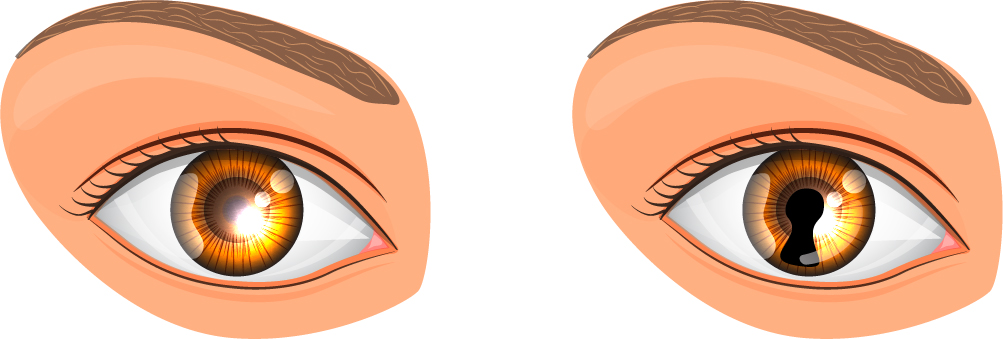Colobomas
Key-hole Pupil
Have you ever seen a keyhole-shaped pupil? This is called an iris coloboma. A coloboma is a congenital abnormality of the eye that occurs because one or more parts of the eye do not close correctly during development.
How do People Get Colomobas?
Colobomas are congenital defects of either the eye or the eyelids. During development, the eyes begin as a cup-shaped structure that then zips closed along the bottom. Disrupting this closure process can cause missing eye or eyelid tissue. The severity of the defects and their impact on visual functioning depend on which structures of the eye are affected and to what extent. Colobomas can occur either spontaneously or be inherited. Sometimes they are associated with other congenital anomalies, such as CHARGE syndrome or Goldenhar syndrome. Therefore, an infant with a coloboma should be carefully evaluated by their pediatrician for other congenital anomalies.
Eyelid Colobomas
A coloboma of the eyelid appears as a vertical notch or missing portion of the center of the eyelid. It typically affects the upper eyelid. Eyelid defects can damage the surface of the eye because of exposure and dryness. An eyelid coloboma can usually be repaired by your pediatric ophthalmologist or an oculoplastic surgeon.
Iris Colobomas
An iris coloboma will have the appearance of a keyhole pupil with a notch at the lower edge. Interestingly, an iris coloboma often does not hurt vision. You can have colobomas of other eye structures that may have a major effect on vision, such as retinal or optic nerve colobomas. However, an iris coloboma may be associated with other eye issues that can affect vision. A complete eye examination by a pediatric ophthalmologist is needed.
Fundus Colobomas
Fundus colobomas are defects that occur inside the eye and affect the retina or optic nerve. Many retinal colobomas are at the bottom of the eye and do not affect vision. However, larger colobomas, or ones that involve the central retina or optic nerves, may cause severe visual impairment. Your pediatric ophthalmologist should also watch fundus colobomas carefully over time to observe for any sign of retinal detachment, one possible complication of the coloboma.
Final Notes
A child with an iris coloboma needs to have a complete eye exam to rule out other more serious eye abnormalities. Also, colobomas may be a sign of more serious systemic abnormalities or syndromes, especially if both eyes are affected.
For further details, check out this article from the AAPOS website.
To schedule an appointment, call (509) 456-0107

